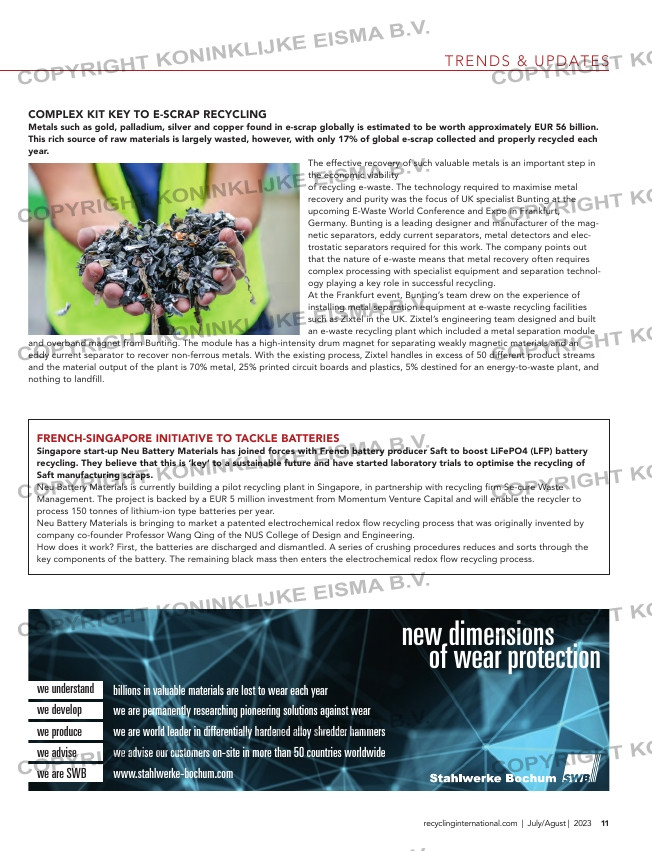Page 11 from: Recycling International – July/August issue 2023

TRENDS & UPDATES
11recyclinginternational.com | July/Agust | 2023
Fotobijschrift
AURUBIS ‘DEEPLY SADDENED’ BY WORKER DEATHS
An investigation is underway into the cause of a nitrogen leak at an Aurubis smelter in Germany which resulted in the death of
three employees.
It happened in the early hours of 11 May at the Primary Smelter Plant East in Hamburg. Two employees succumbed to their injuries in
hospital later that day and a third died four days afterwards. A memorial service was held on 16 May.
‘We are deeply saddened by this terrible tragedy,’ said Aurubis ceo Roland Harings. ‘Our hearts go out to their loved ones and every-
one else affected. We want to express our deepest sympathy.’
Aurubis said it was working closely with the authorities as they conducted a detailed investigation into ‘the root cause of the accident’.
On the day of the incident, the company said a leak of nitrogen occurred while the three employees were conducting regular mainte-
nance on the Primary Smelter Plant East, a central part of metal production in Hamburg.
Although the plant is a primary smelter, the company says ‘they also use copper scrap to a certain extent’.
COMPLEX KIT KEY TO E-SCRAP RECYCLING
Metals such as gold, palladium, silver and copper found in e-scrap globally is estimated to be worth approximately EUR 56 billion.
This rich source of raw materials is largely wasted, however, with only 17% of global e-scrap collected and properly recycled each
year.
The effective recovery of such valuable metals is an important step in
the economic viability
of recycling e-waste. The technology required to maximise metal
recovery and purity was the focus of UK specialist Bunting at the
upcoming E-Waste World Conference and Expo in Frankfurt,
Germany. Bunting is a leading designer and manufacturer of the mag-
netic separators, eddy current separators, metal detectors and elec-
trostatic separators required for this work. The company points out
that the nature of e-waste means that metal recovery often requires
complex processing with specialist equipment and separation technol-
ogy playing a key role in successful recycling.
At the Frankfurt event, Bunting’s team drew on the experience of
installing metal separation equipment at e-waste recycling facilities
such as Zixtel in the UK. Zixtel’s engineering team designed and built
an e-waste recycling plant which included a metal separation module
and overband magnet from Bunting. The module has a high-intensity drum magnet for separating weakly magnetic materials and an
eddy current separator to recover non-ferrous metals. With the existing process, Zixtel handles in excess of 50 different product streams
and the material output of the plant is 70% metal, 25% printed circuit boards and plastics, 5% destined for an energy-to-waste plant, and
nothing to landfill.
MULTI-MILLION INVESTMENT
INTO US BATTERY RESEARCH
The Argonne National Laboratory has
received US$ 3.5 million (EUR 3.2 mil-
lion) from the US government to help
accelerate sustainable battery produc-
tion in America.
The grant is part of a US$ 7 billion
investment by the US Department of
Energy to strengthen the domestic bat-
tery supply chain. The money is for
extraction and recycling efforts to lower
the environmental impact of electric
vehicle batteries while also cutting pro-
duction costs. Grants will be matched
with funding from the receiving compa-
nies.
The demand for critical battery compo-
nents, such as lithium and graphite, are
projected to increase significantly in the
coming decades, according to Argonne’s
battery recycling specialist Jeffery
Spangenberger, who heads the insti-
tute’s ReCell Center. ‘If this problem is
not addressed, it could limit the devel-
opment and adoption of clean energy
battery technologies.’
He estimates that nearly eight million
tonnes of EV batteries may be available
for recycling by 2040. ‘Tapping them for
our metal needs can reduce emissions
by as much as 16 million tonnes a year
while also providing a much-needed
domestic source for battery materials.’
His team is ‘excited to have this great
opportunity’ to help advance battery
recycling technology and to support
efforts to expand commercial-scale
‘green’ battery materials manufacturing
in the US. They are working on half a
dozen battery specific partnerships.
new dimensions
of wear protection
we understand
we produce
we advise
we are SWB
billions in valuable materials are lost to wear each year
we advise our customers on-site in more than 50 countries worldwide
we are world leader in differentially hardened alloy shredder hammers
we are permanently researching pioneering solutions against wear
www.stahlwerke-bochum.com
we develop
FRENCH-SINGAPORE INITIATIVE TO TACKLE BATTERIES
Singapore start-up Neu Battery Materials has joined forces with French battery producer Saft to boost LiFePO4 (LFP) battery
recycling. They believe that this is ‘key’ to a sustainable future and have started laboratory trials to optimise the recycling of
Saft manufacturing scraps.
Neu Battery Materials is currently building a pilot recycling plant in Singapore, in partnership with recycling firm Se-cure Waste
Management. The project is backed by a EUR 5 million investment from Momentum Venture Capital and will enable the recycler to
process 150 tonnes of lithium-ion type batteries per year.
Neu Battery Materials is bringing to market a patented electrochemical redox flow recycling process that was originally invented by
company co-founder Professor Wang Qing of the NUS College of Design and Engineering.
How does it work? First, the batteries are discharged and dismantled. A series of crushing procedures reduces and sorts through the
key components of the battery. The remaining black mass then enters the electrochemical redox flow recycling process.
10-11-12-13-14-15_trendsupdates.indd 11 05-07-2023 14:18



